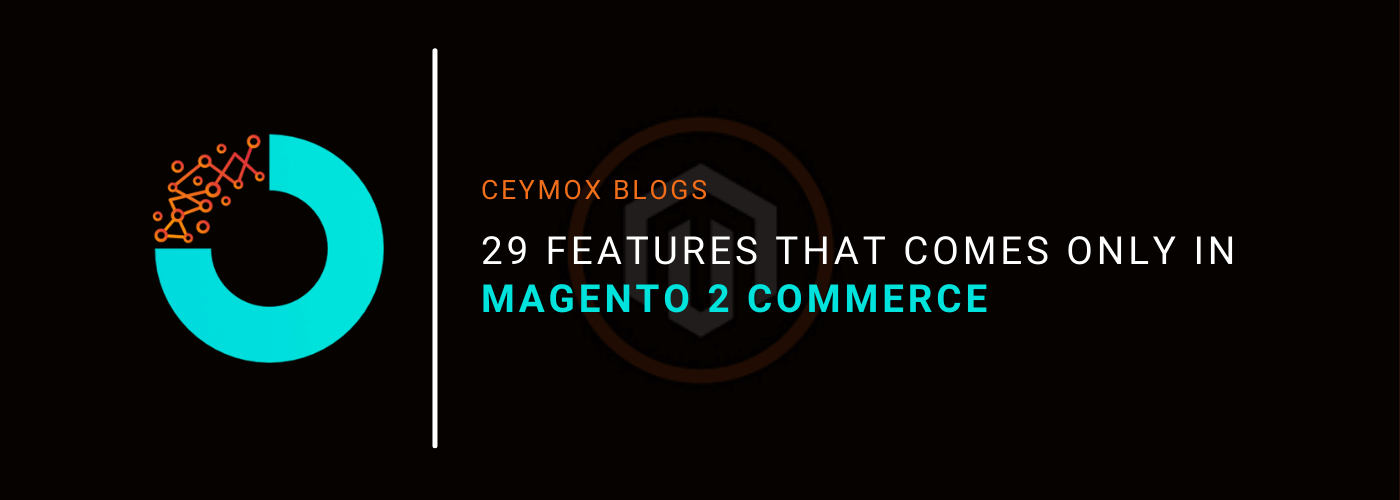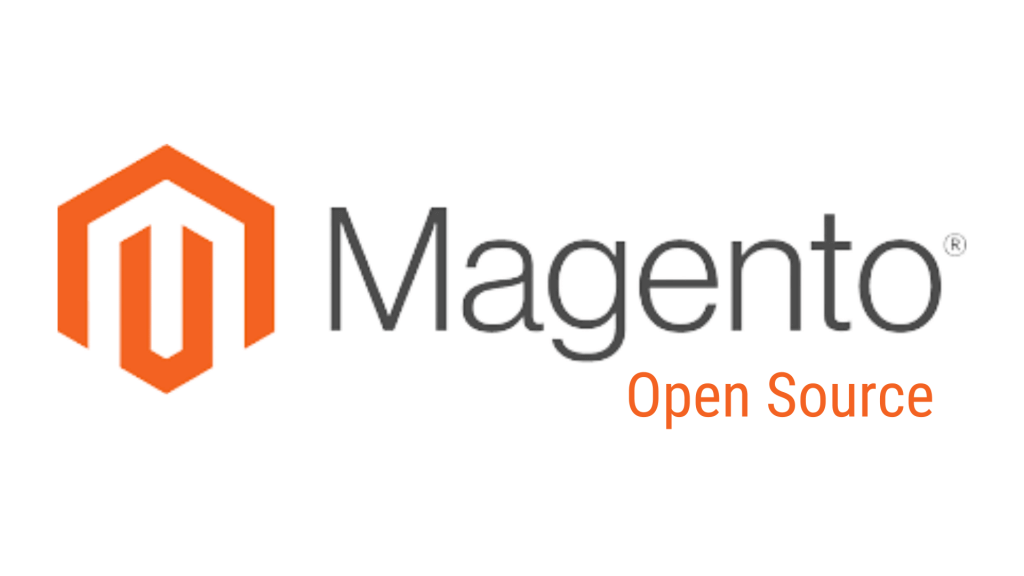
Whether it is a startup, a mid-level industry or a large organization, Magento 2 has become a primal choice for every industry. The mid-to enterprise-level organizations tend to use Magento Commerce because of its out-of-the-box features. These features can bring your e-commerce operations to the next level.
In this article, we will be knowing about these 31 features which make Magento Commerce, a great platform to invest in and use for your e-commerce operations.
Magento Commerce Vs Magento Open-Source:


Most of the Magento users prefer to use the Magento Community version as it is open-source and free of cost. But as your business grows online, this free version is not capable of handling your large-scale e-commerce activities. But first, let’s know the difference between Magento 2 Open Source and Magento 2 Commerce.
If you are looking for a free version of Magento 2 then you can give it a try to Magento 2 Open Source. This version is efficient for small businesses and startups who have just started their path in the e-commerce industry. They can hire a Magento developer for setting up the store. You can find many upgrades between Magento 1 Community’s edition and Magento 2’s Open source.
Magento Commerce, on the other hand, is the paid edition of the Magento platform. It comes with all the features of Magento Open-source and many additional features. In this Magento edition, the Magento store owner doesn’t have to worry about the performance and security of the server. In Magento Open-source, you will be responsible for managing infrastructure. You will have to work with the hosting provider to create a plan which can meet sudden traffic surges while Magento Commerce cloud has been designed to scale fast. Instead, you just have to pick up your phone or send mail.
Features Comparison:
Magento provides resources that will let you compare Magento Open-source and Magento Commerce such as the PDF outlining the entire feature set of Magento Commerce. But during making a purchasing decision, these files will make you even more confused. Even after going through several guides, you have to painstakingly search through each User Guides for differences.
Nobody has time for this much research. Thus we thought to list down the Magento Commerce only features which are not present in Magento open-source. We hope that this features list will let you easily identify Commerce-only features and make better purchasing decisions.
Who we are?
At Ceymox Technologies, the best Magento development company in India, we have built more than 300 Magento stores from scratch. We have experience in Magento development for more than a decade, and we have been continuously updating our clients with the latest Magento news, articles, and blogs. Our team of certified Magento developers will help you in understanding and executing each and every requirement.
29 Features that come only in Magento 2 Commerce:
Yes, we will be telling you about those features which are present only in Magento 2 Commerce.
Here’s the list:
- Category Permissions
- Gift Cards
- Advanced Catalog Search
- Staging Content
- Page Hierarchy
- Customer Segments
- E-mail Reminders
- Gift Registries
- Google Tag Manager
- Private Sales & Events
- Related Product Rules
- Rewards & Loyalty
- Visual Merchandiser
- Wishlists
- Additional Payment Methods
- Gift Options
- Order Archiving
- Order by SKU
- Returns
- Shopping Assistance
- Store Credit
- Customer Attributes Manager
- Action Logs Report
- Scheduled Import/Export
- Support Tools
- Shared Catalogs (B2B)
- Company Accounts (B2B)
- Quick Order (B2B)
- Quotes (B2B)
- Payment on Account (B2B)
- Requisition Lists (B2B)
We will discuss each of these features in more detail.
1. Category Permissions:
Using these features, the merchants can restrain the access for browsing the product categories, checking prices, or adding a product to cart for a customer group within a product category. You can check the complete procedure of Category Permissions here.
2. Gift Cards:
Gift Cards have become a highly powerful marketing tool and can improve sales, conversion rates, and build customer loyalty. It is quite a pleasant commodity that customers like to purchase and receive. The Magento merchants can sell physical, virtual, or combined gift cards. The complete record of Gift cards can be managed through Gift Card accounts within the Magento dashboard.
3. Advanced Catalog Search:
The latest Magento version “Magento 2.4.2” supports Elasticsearch. It is a very powerful and scalable search engine that is used by many popular websites including Wikipedia, eBay, and GitHub. You can configure the search here.
4. Staging Content:
The merchants can create new content, preview it, and schedule the changes of content in products, categories, promotions, and other pages using Content staging. It is highly useful when your objective is to schedule on-site marketing for a new promotion, especially when you are not in the office. Know more about Content Staging here.
Magento Commerce also comes with an exciting dashboard for scheduled content, the Staging dashboard.
5. Page Hierarchy:
The merchants can add & organize content pages within a hierarchy and can have different attributes like pagination, navigation etc. It comes with an easy drag & drops admin interface. Know more about Page hierarchy here.
6. Customer segmentation:
Customer segmentation is highly useful while running an e-commerce store. In Magento, it is quite easy to generate, develop and implement a segmented list. E-mail marketing is amongst the important marketing strategies and it doesn’t work without involving segmented lists. The merchants can display different content to a particular group of customers. Know more about Customer segmentation here.
Also, the Customer Segment Report allows merchants to measure the number of customers in each segment.
7. E-mail Reminders:
Whether you need to remind customers for their abandoned cart or inform them about the availability of a product that was earlier out of stock, you will require the functionality of E-mail reminders. These e-mails will encourage the customer to return to your site and make a purchase. Know more about e-mail reminders here.
8. Gift Registries:
The customer can create registries for special occasions through gift registries. They will invite their kith & kin to purchase the gifts. Magento comes with a Gift Registry Search widget which allows the customers to search for other customer’s registries.
9. Google Tag Manager:
Using Google Tag Manager, an online seller can manage several tags for analyzing and tracking customer activity, personalizing content, retarget, conducting external marketing initiatives, and much more.
The support for Google Tag Manager and Google Analytics Enhanced Ecommerce is provided only in Magento Commerce.
10. Private Sales & Events:
Using Private Sales & Events, the Magento merchants can create sales that will be accessible only to the logged-in customers. Also, the customers would be able to send invitations to other customers.
The Private Sales Report will give you the info. about the invitations send, accept, rejected, and the conversion rate. Know more about the Private Sales Report here.
11. Related Product Rules:
You must have seen the related products section within a Product details page. Using the Related Product Rule in Magento Commerce you can set several rules for related products, up-sells, cross-sells, displaying them conditionally instead of manually. This is one of the most powerful features of Magento commerce. Know more about Related Product rules here.
12. Visual Merchandiser:
If the merchants want to merchandise i.e. define the order in which products appear within a category, then they can use the feature of Visual Merchandiser. It is possible through a drag and drop interface, or by applying rule-based conditions powered by “Smart Attributes”.
13. Wishlists:
Wishlists are necessary if a customer demands any product which is not in stock. The Wishlist feature will allow customers and site admin to manage the wishlists on a customer’s account. This feature is quite similar to the Gift registries but when an item is purchased from a wishlist it doesn’t get removed from the original wishlist.
14. Additional Payment Methods:
There are many additional payment methods such as Paypal, Braintree, Klarna, Amazon Pay, etc. which are supported in Magento Commerce.
15. Gift Options:
If the customers want to add a special message or want to wrap a product like a gift then you can give these options to the customers through Gift Options in Magento Commerce. You can also add a gift receipt or a printed gift card. These may be offered as an additional charge.
16. Order archiving:
For optimizing the backend of your Magento commerce you must archive or remove the unnecessary information. Order archiving will clean the workplace and improves performance. The invoices, shipment and credit memos can be archived automatically or manually.
17. Order by SKU:
If you want to add products to a shopping cart simply by entering SKU and quantity information then you must use the Order by SKU feature. You can also upload a CSV file from a customer account.
18. Returns:
Return Merchandise Authorizations, RMAs or Returns gives you the ability for returns, refund or replacement for a product in your online store. Many customers return the purchased products by entering the information of order within the Order & Returns section.
If the product is eligible for a return, then an RMA number will be assigned for identifying the returned product. You can even enable RMA for all products or certain products.
19. Shopping Assistance:
A customer who has registered his/her account on the e-commerce website may require Shopping Assistance. This feature will help in that. The merchants are able to edit the contents of the customer’s shopping cart in real-time from the Admin panel. Also, a customer service executive can see the content of the customer’s cart if the customer is in contact with the customer service team.
20. Store Credit:
The merchants can refund customers for cash purchases through the Store Credit functionality. Customers then use that store credit for paying purchases, track the status of refund,s and much more. A credit memo is quite different from a refund. Credit goes back to the customer’s account but can be used later for future purchases.
21. Customer Attribute Manager:
Apart from the default attributes of a customer, if you want to add additional customer attributes then you can use Customer Attribute Manager. It will help in supporting order, fulfillment, and customer management purchases. Also, you can the additional attributes in the Billing information section during checkout, or when a guest user registers.
22. Action Logs Report:
For keeping the detail of every action of the admin, you can use the Action Logs Report feature of Magento Commerce. In each record, IP address, user name, will be recorded. It will also include admin user data and related changes made during the auction.
23. Scheduled Import/Export:
For scheduling the imports and exports on a daily or monthly basis, you can use schedule import/export. It is highly useful when integrating 3rd party services. The other features are Advanced Pricing, Products, Customers & Addresses, Customer main file, and customer addresses.
24. Shared Catalogs (B2B):
The merchants can use shared catalogues with custom pricing, products, and permissions for different companies. But these catalogues will be available for only particular customer groups, and custom catalogues may be created which are visible to only members of specific company accounts.
25. Company Accounts:
After enabling the company accounts feature, a site visitor can request for opening a company account, or a site administrator can create the company account.
When the admin will approve the admin account, the admin will be able to set up the structure, add users & teams.
26. Quick Order:
Just like Order by SKU, the customers can add products to their cart by just entering SKU and quantity information directly into the Quick Order Interface, or by Uploading a CSV file.
27. Quotes:
You can add an authorized buyer from a company through B2B Quotes. The buyer will be able to initiate a price quote from the shopping cart.
Merchants can manage quote requests within the admin interface, view a history of the communication between buyer and seller, save views, and export data.
28. Payment on Account:
If you want an additional offline method on your Magento store then you can use Payment on Account functionality in B2B. It will allow the companies to make purchases up to the credit limit that is specified in their profile.
You can enable this feature either globally or per company. It appears during checkout-only enabled.
29. Requisition Lists:
The B2B customers can maintain their requisition lists which is almost similar to the wishlist but the products are not removed after they have been purchased. The primary reason to maintain a requisition list is to make it easy to reorder products.
For instance, items from a requisition list can be easily added to the shopping cart or moved or copied from one requisition list to another.
Wrapping Up:
In this article, we have gone through almost every feature which is present in Magento Commerce and not in the free version Magento Open-source. At Ceymox Technologies, we will give you the best guidance while choosing the Magento edition for your e-commerce store. Let us know when we can connect.
 Hubspot SEO Certified |  Hubspot SEO II Certified |  Google Ads Search Certified |  Google Analytics Certified |
Sreehari N Kartha is a skilled Digital Marketing Analyst at Ceymox, certified in SEO. His expertise encompasses a wide range of digital marketing strategies, including managing advertising campaigns on platforms like Google Ads, Facebook Ads, Instagram Ads, WhatsApp Ads, and LinkedIn Ads. With a strong foundation in SEO and SMM, Sreehari is adept at optimizing online visibility, driving engagement, and generating qualified leads and conversions. His passion for emerging technologies, such as Crypto, NFTs, and Web3, further complements his skillset, enabling him to navigate the dynamic digital landscape.
View All Articles